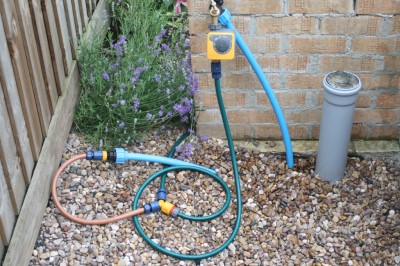






If you’re curious about soaker hoses stocked alongside regular hoses in the garden store, take a few minutes to investigate their many benefits. That funny-looking hose is one of the best gardening investments you can make.
If a soaker hose looks a little like a car tire, that’s because most soaker hoses are constructed from recycled tires. The hoses have a rough surface that hides millions of tiny pores. The pores allow water to seep slowly into the soil.
The main advantage of a soaker hose is its ability to wet the soil evenly and slowly. No precious water is wasted by evaporation, and water is delivered directly to the roots. Soaker hose irrigation keeps the soil moist but never waterlogged, and the foliage remains dry. Plants are healthier and root rot and other water-related diseases are minimized.
Gardening with soaker hoses is convenient because the hoses remain stationary, which eliminates the need to drag heavy hoses every time you want to water.
Soaker hoses come in a roll, which you cut to the desired lengths. As a general rule, it’s best to limit lengths to 100 feet or less to provide even water distribution. Some people even make their own soaker hoses by recycling an old garden hose. Simply use a nail or other sharp object to tap small holes every couple inches or so along the length of the hose.
You’ll also need connecters to attach the hoses to the water source and an end cap for each length. For a more sophisticated system, you may need couplers or valves to allow you to easily switch from area to area.
Lay the hose between rows or weave the hose through plants in a flower bed. Loop the hose around plants that need extra water, but allow a few inches between the hose and the stem. When the hose is in place, attach an end cap and bury the hose with bark or another type of organic mulch. Don’t bury the hose in the soil.
Allow the hose to run until the soil is damp to a depth of 6 to 12 inches, depending on the needs of the plant. Measuring soaker hose output is easy with a trowel, a wooden dowel or a yardstick. Alternatively, apply approximately an inch of water every week in spring, increasing to 2 inches when the weather is warm and dry.
After you water a few times, you’ll know how long to run the hose. This is a good time to attach a timer — another time-saving device.
Tips And Tricks On How To Get The Best Organic Garden
Growing Basil Plants And How To Use The Basil Leaves
Lawn Aeration and the Use of Top Dressing Soil
How to Use Marigolds in the Garden to Repel Deer
What Is A Garden Trellises And How Is It Used In The Garden?
Copyright © www.100flowers.win Botanic Garden All Rights Reserved